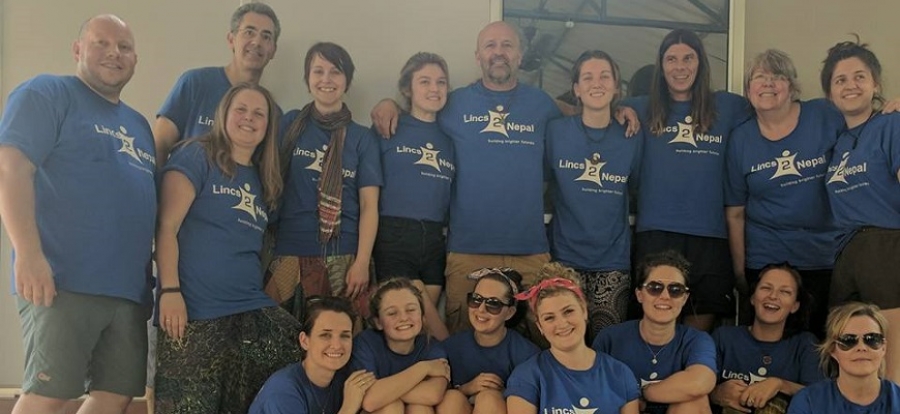Reflective leading
To lead, you must have a hide so tough that it will not pierce under the pointy stare of criticism, but not so impenetrable that the criticism does not reach your thinking brain. The only way to avoid criticism is to do absolutely nothing (not exactly a leadership stance). When criticism comes you must stop and think, “Is this true? Is this helpful?” If the answer is “yes”, use it to explore a solution. If the answer is “in all honesty, no”, let it go. One team member, who came from an education background, told me that before they arrived they had thought me arrogant. “Who is she to tell me how to lead training?” She had led training before and didn’t see why I had given instructions on workshop content and composition.
I was aware that the volunteers would question my planning, methods and ideas, but I was also confident that what we were doing was well planned with clear, successful outcomes in mind. This was my second visit to Nepal. “With our core improvement plan, we avoided overcomplicating future training.”In the first visit, I had already learned many lessons and adapted our planning in light of them. For example, I now know that training in England which would take one hour could take up to a full day when helping EAL teachers to process new learning. I had learned that by linking all learning to our core improvement plan, we avoided overcomplicating future training. I had learned that, no matter how well laid the plans, things go wrong and you must be prepared to think on your feet and change fast.
My confidence in our vision for the training had to be stronger than my fear of criticism. Listening to all suggestions and confidently weighing them up against our intended outcomes, I remained strong in our vision without being pig-headed in adapting when an excellent idea was shared. The ‘arrogance’ preconception was a short lived, made possible by very human leadership.

Teacher Training Day
Human leading
Being human and recognising the humanity in others can help you make a success of leadership in even the most unfamiliar of contexts. Looking upon each volunteer as an individual with their own set of preconceptions, fears, learning and expectations, getting to know their unique starting points kickstarted and grew our working relationship. Leading a team of adults can be much like learning about a new class of children. There were tears, tantrums, fall outs, over-excitement, illness and nerves, to name just a handful of human traits that had to be carefully dealt with. At no time could I succumb to fear myself. As a leader, it was my job to explore solutions and not to complain about the problems.
Knowing that everything we do comes from a fear of discomfort (failure, pain, humiliation, embarrassment) or an anticipation of reward (happiness, success, learning, pride) helped me to establish the route of many situations and explore solutions that kept us working together as a team. As a leader, you will experience human problems. They only remain problems if you do not unselfishly seek out the route of their fear, and explore the path to anticipation of success. Watching young teachers grow from nervous planning to looking ten feet taller, following the successful delivery of their workshops, has such a rewarding feeling that, as a leader who has experienced this success, you know it is worth the time spent on troubleshooting the fear.
Imagine that you have asked a member of your team to plan a professional development session to be delivered to teachers. The deadline has passed for delivering the outline to you. They avoid you in the corridors and have stopped answering emails. How do you react? You could find them asap and demand an explanation. Tell them that this is their job and that they are not delivering to your expectations. Or you can explore the possibilities. Why have they not yet delivered what is needed? Where is the fear coming from? Are they scared that they don’t have enough knowledge? Are they afraid their outline will not be what you are expecting? Questioning the fear can lead to solutions. Demanding an answer can perpetuate the fear. Which one do you think will lead to the desired outcome?
Creative leading
Taking everyone’s specialities into account, we had planned for a day of fun for our 25 Nepalese teachers. The dance student sixth-formers were to lead them in western dance; our creative librarian was to lead a craft workshop; workshops in creative writing, woodwork, storytelling and more had all been designed with our 25 teachers in mind. The day before our fun day, we were told that it wasn’t just 25 teachers… the school were also expecting 300 children to turn up that day. What would you do? The fear will naturally kick in. You will want to give up on the idea and hand the school back to the teachers, stepping back and avoiding the hassle.

Dollies in the trees
A creative leader does not see a problem. They see potential! Back to the drawing board and fast! How can we make this work? What do we have already that we can scale up? How can we adapt for success? The volunteers were petrified at first but, as a leader, “A creative leader does not see a problem. They see potential!” you cannot allow their fear to affect you. Instead, you must let your enthusiasm and belief in the potential of the situation inspire them. Creative leaders don’t crumple when they get an inspection judgement they don’t want. Creative leaders don’t quit just because exam results come back less than expected. Creative leaders see potential in the situation and motivate their staff towards a successful next step.
We worked late that night. More resources were made. Plans to ensure smooth running were laid out and gone through over and over. Everyone had a role. Confident volunteers were paired with the nervous to support each other. Overwhelmed volunteers were provided help from those who had time to spare. Fractions between volunteers were discussed calmly and mediated to solutions quickly. As a leader, it was my role to recognise how people were feeling and what they needed to make their role a success.
When something big explodes and you are in charge. Expect fear in your followers. Anticipate the fear and look for solutions to disperse it. Getting angry that your followers have wimped out on you will not lead to success. Only confidence, understanding and exploring realistic solutions can lead you there.
The fun day went ahead! 25 teachers and 300 children took part in varied and engaging workshops delivered by our team. Crafts, storytelling, dancing, singing, all went off without a hitch. There was a moment that day that I stopped to take it all in. I stood back as the unseen conductor of the orchestra. The stars were running the show. I listened to the buzz of happy children, chattering teachers, confident volunteers and activities of all kinds; I watched the colours of the dancing dollies in trees and movements of the newly learned western dances. My heart swelled to twice its size with pride in what we had achieved as a team. This, I thought, this right here is the reward of the hard work of leadership. When you can step back and watch as those you have led come into their own and make it all work perfectly.

Dance lessons
Working in education increasingly means working in unfamiliar and unpredictable landscapes. Exam expectations change, cohorts of children differ, changes to your working life at the whim of a government come and go so frequently that your head spins and you struggle to keep your feet on the ground. If you are a leader in this land, remain strong in the face of chaos. Reflect upon your mission. What are your intended outcomes? Stay true to your core purpose, and do not let the fear overwhelm you. Remain human and remind yourself of the humanity of those you lead. Do not let your fear or the fear of others get in the way of doing what is right. When problems arise, get creative! Ask yourself where the potential lies and lead the human resources around you to success. Leading is a great responsibility, a responsibility that comes with overwhelmingly powerful reward if you remain focussed on your core purpose and remain confident that your team can produce success.
Want to receive cutting-edge insights from leading educators each week? Sign up to our Community Update and be part of the action!


















